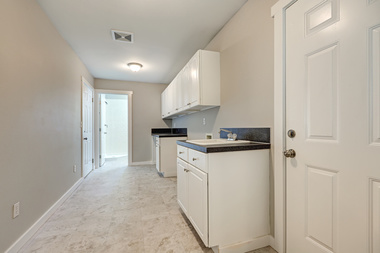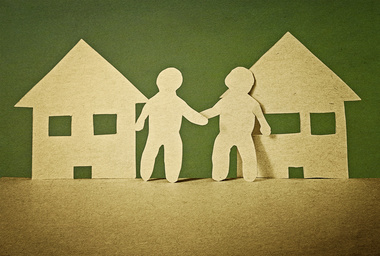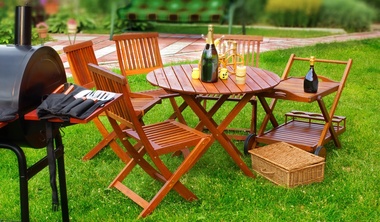How to Organize Your Mudroom
First of all, mudrooms are fantastic; there is just no other way to say it. Any floor plan that includes a mudroom is a good one. The downside to a mudroom is that the mess can get out of hand in a hurry. But that's where these five mudroom organization tricks to keep you sane come in handy.
1. Set expectations and be realistic, because there is no point in venturing off to find the ultimate mudroom organizer if it doesn't match your lifestyle. Keeping the clutter to a minimum is the goal. What is the best means to an end for your household? Consider the most urgent need and buy accordingly. If you're a 1,000-pairs-of-flip-flops family, find the right shoe system for you. The same theory applies if your Hunter rain boot collection appears in lifestyle magazine features.
One suggestion is that before you purchase anything, you address your flooring situation. Are you happy with it or could it use improvement? Rugs or carpet tiles absorb sound and outside debris, which means less noise and dirt in the house.
2. The simple route is to buy a mudroom organization kit, and if you're not into DIY, have someone else put it together and install it. This course lets the experts do what they do best, and you reap the rewards. A win-win for everyone.
3. For the DIY crew out there, mudroom organization is an upcycler's dream come true. Repurpose old lockers, TV stands, bookshelves or shoe racks for storage containers. Get crafty with paint colors, stains and structural engineering to create a customized schematic for your busiest room.
4. Pegboards are ideal for families with youngsters. As the wee ones grow, the pegboard adjusts to fit their needs. You can insert coat hooks made from durable materials in shapes safe for the age of your child. Bags, baskets, shelves, cubbies or whatever container works best for you all fit nicely onto pegboards.
5. You can never own enough storage baskets — end of story. Somehow they manage to wander off to some distant basket vacation land. For mudrooms, baskets (in theory) keep matching shoes together and act as a hamper for dirty socks, and they look good. And, if you have budding athletes, baskets are good targets for practicing one's aim.
Bonus trick: Do a test run before committing to your final scheme. The placement may work great in your head, but what about in real-life application? Additions like a bench or other seating might be necessary to maximize the organizational possibilities. Or, in the desire to avoid clutter, did you overbuy containers? Does the room still feel chaotic? Don't forget about wall space to keep things off the floor.
Good luck with your new super-useful mudroom!

1. Set expectations and be realistic, because there is no point in venturing off to find the ultimate mudroom organizer if it doesn't match your lifestyle. Keeping the clutter to a minimum is the goal. What is the best means to an end for your household? Consider the most urgent need and buy accordingly. If you're a 1,000-pairs-of-flip-flops family, find the right shoe system for you. The same theory applies if your Hunter rain boot collection appears in lifestyle magazine features.
One suggestion is that before you purchase anything, you address your flooring situation. Are you happy with it or could it use improvement? Rugs or carpet tiles absorb sound and outside debris, which means less noise and dirt in the house.
2. The simple route is to buy a mudroom organization kit, and if you're not into DIY, have someone else put it together and install it. This course lets the experts do what they do best, and you reap the rewards. A win-win for everyone.
3. For the DIY crew out there, mudroom organization is an upcycler's dream come true. Repurpose old lockers, TV stands, bookshelves or shoe racks for storage containers. Get crafty with paint colors, stains and structural engineering to create a customized schematic for your busiest room.
4. Pegboards are ideal for families with youngsters. As the wee ones grow, the pegboard adjusts to fit their needs. You can insert coat hooks made from durable materials in shapes safe for the age of your child. Bags, baskets, shelves, cubbies or whatever container works best for you all fit nicely onto pegboards.
5. You can never own enough storage baskets — end of story. Somehow they manage to wander off to some distant basket vacation land. For mudrooms, baskets (in theory) keep matching shoes together and act as a hamper for dirty socks, and they look good. And, if you have budding athletes, baskets are good targets for practicing one's aim.
Bonus trick: Do a test run before committing to your final scheme. The placement may work great in your head, but what about in real-life application? Additions like a bench or other seating might be necessary to maximize the organizational possibilities. Or, in the desire to avoid clutter, did you overbuy containers? Does the room still feel chaotic? Don't forget about wall space to keep things off the floor.
Good luck with your new super-useful mudroom!



